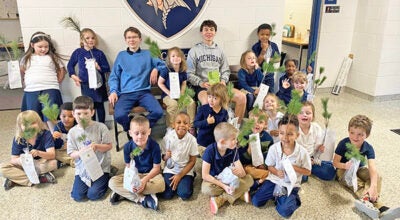Tips for spotting tree pests during the winter
Published 8:48 am Tuesday, December 5, 2017
The winter months are not often the time people think about the forest or yard trees, but they can be a great time to assess how trees are doing against a slew of new and old forest pests. Though some issues are easiest to see during spring and summer, such as oak wilt, many are noticeable throughout the year and some, such as Hemlock wooly adelgid, are coming to the forefront as snow starts to fall.
The SWxSW Corner CISMA and the local conservation district are urging homeowners to take a look this winter to help protect Michigan’s forests. The CISMA, located in local conservation district offices, is taking reports of forest pests to offer assistance, treatment recommendations, and monitoring.
HWA is often easiest to see in the winter, so now is the time to start keeping an eye out for the distinct white “wooly” insects at the base of hemlock needles. Once the insect has matured, it crawls to the base of a needle and hunkers down, where it creates this distinct white coating and starts sucking out the sugars and nutrients the tree produces. Though HWA will affect the tree anywhere, it often starts in the top branches and moves down.
“We don’t yet know of any HWA cases in Van Buren, Berrien, or Cass counties, though we do know that it’s been reported just north of us,” said Nor Serocki, coordinator for the CISMA. “If we find it early, when only a tree or two is infected, we have a much better chance of saving our hemlock forests.”
Asian longhorn beetle has not been reported in Michigan, but is on the CISMA’s “watch list” because of its potential to impact most hardwood species of trees in the state. The larval of this large beetle can eat its way through the growing tissue of the tree, eventually girdling it. Though the beetles won’t be visible now, tree owners are advised to look for pencil-size exit holes on hardwood species, along with rough egg laying sites and what looks like sawdust at the base of trees.
Lastly, beech bark disease is much more of a known problem in northern Michigan and the Upper Peninsula, but could also become a threat to this distinctive tree in the area. This fungus, carried by a non-native scale insect, can kill mature beech trees which produce the nuts that can make up a large part of the available food in the forests. The fungus can be indicated by waxy white spots of the insect secured into a feeding site on the tree, especially in areas where the bark is rougher from damage, lichen, or old branches.
Even if invasive species are not located, residents can still take action to keep them out. The best offense against any invasive species is an early and consistent defense. Serocki advised sourcing firewood, and any Christmas trees or boughs, locally.
“Most bugs or fungi can’t move very far on their own, but we can give them a free ride in by moving infected wood,” Serocki said.
Another key tip? Move any bird feeders away from hemlock trees, since the insects are so small they can easily be moved from tree to tree on birds landing in the branches.
The Southwest X Southwest Corner Collaborative Invasive Species Management Area is a grant funded program to manage invasive species in Berrien, Cass, and Van Buren counties. With funding from the Michigan Invasive Species Grant Program, the CISMA aims to help landowners and stakeholders in the Southwest Michigan area manage invasive species. For more information, contact the CISMA at (269) 445-8641 ext. 5 or email photos and address or latitude/longitude to: kimberly.barton@macd.org.






